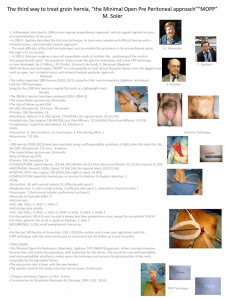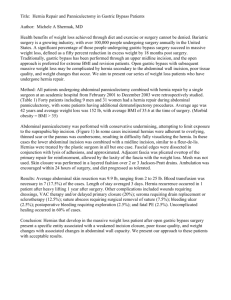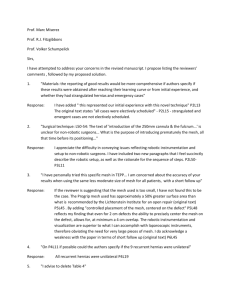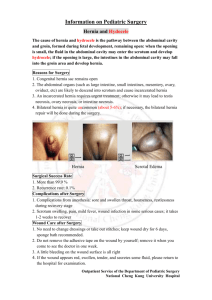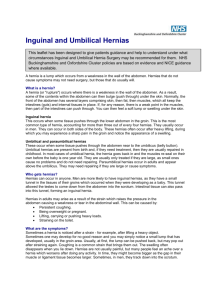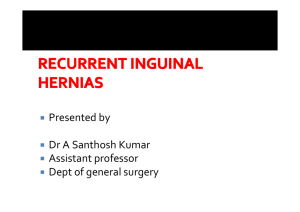A hernia of the abdomen is when there is a "hole" in the abdominal
advertisement
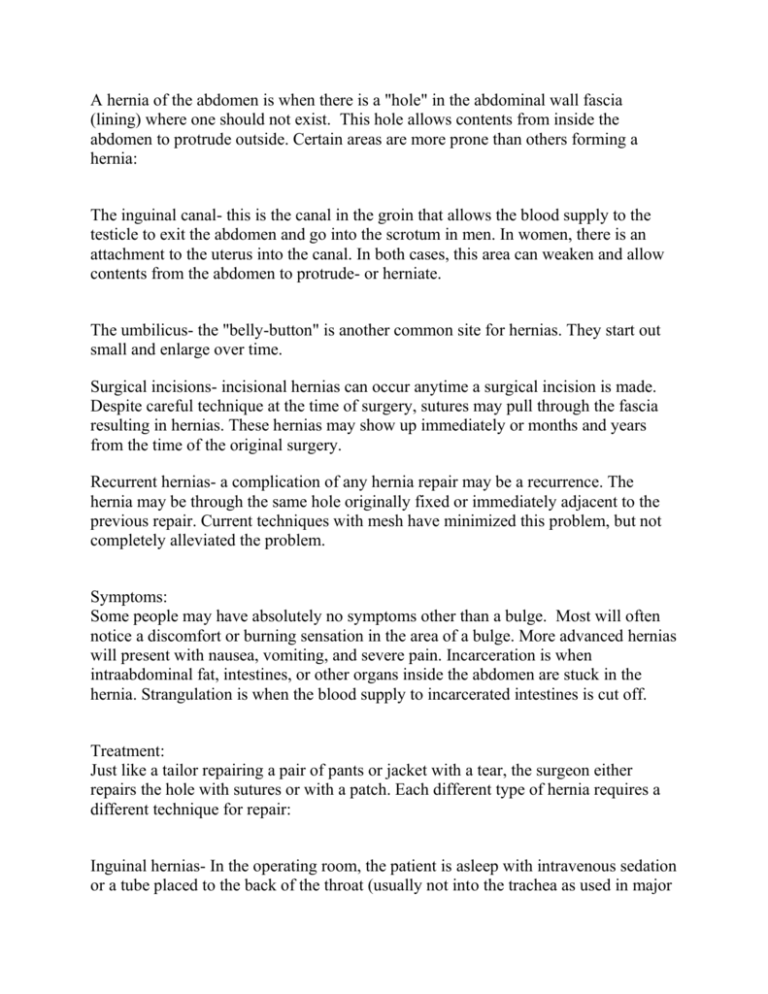
A hernia of the abdomen is when there is a "hole" in the abdominal wall fascia (lining) where one should not exist. This hole allows contents from inside the abdomen to protrude outside. Certain areas are more prone than others forming a hernia: The inguinal canal- this is the canal in the groin that allows the blood supply to the testicle to exit the abdomen and go into the scrotum in men. In women, there is an attachment to the uterus into the canal. In both cases, this area can weaken and allow contents from the abdomen to protrude- or herniate. The umbilicus- the "belly-button" is another common site for hernias. They start out small and enlarge over time. Surgical incisions- incisional hernias can occur anytime a surgical incision is made. Despite careful technique at the time of surgery, sutures may pull through the fascia resulting in hernias. These hernias may show up immediately or months and years from the time of the original surgery. Recurrent hernias- a complication of any hernia repair may be a recurrence. The hernia may be through the same hole originally fixed or immediately adjacent to the previous repair. Current techniques with mesh have minimized this problem, but not completely alleviated the problem. Symptoms: Some people may have absolutely no symptoms other than a bulge. Most will often notice a discomfort or burning sensation in the area of a bulge. More advanced hernias will present with nausea, vomiting, and severe pain. Incarceration is when intraabdominal fat, intestines, or other organs inside the abdomen are stuck in the hernia. Strangulation is when the blood supply to incarcerated intestines is cut off. Treatment: Just like a tailor repairing a pair of pants or jacket with a tear, the surgeon either repairs the hole with sutures or with a patch. Each different type of hernia requires a different technique for repair: Inguinal hernias- In the operating room, the patient is asleep with intravenous sedation or a tube placed to the back of the throat (usually not into the trachea as used in major operations. A four centimeter incision in the groin. The hernia is dissected from the other tissues and returned into the abdomen. Two pieces of mesh are then used to repair the hernia: the first goes into the hole where the hernia used to be. A second piece of mesh covers the first repair as well as the remaining part of the canal. Because there are two types of hernias in the groin, the second piece of mesh prevents the need for a second operation in the future should another hernia occur. Umbilical hernias- For hernias in the belly button less than 4 centimeters (cm), intravenous sedation or a tube placed to the back of the throat may be used. An incision is made below the umbilicus, the hernia replaced back into the abdomen. If the hernia is large enough, a piece of mesh will be used to reinforce the hole. Otherwise, sutures alone ar all that are necessary. Umbilical hernias 4 cm or greater may be better repaired laparoscopically. Under general anesthesia, a piece of mesh is placed into the abdomen and fixed from the inside. The benefit of lapararoscopic repair is even greater overlap of the mesh beyond the edges of the hernia- this prevents recurrences. Incisional hernias- these hernias are more complicated to repair; often there is more than one actual hernia in the line of the previous incision. Repair of a small hernia may be done through the old incision. Large or multiple hernia repairs are usually done laparoscopically under general anesthesia. The key to these repairs is adequate overlap of the mesh with the good fascia around the hernia. Recurrent hernias- ALL hernias, from the smallest to the largest can recur. If the original repair did not involve mesh, the recurrence will most likely require a mesh reinforcement. If mesh has been used, wider coverage of intact fascia is usually required. Both open and laparoscopic techniques can be used, Experience with hernia repairs is the key to a successful repair.


